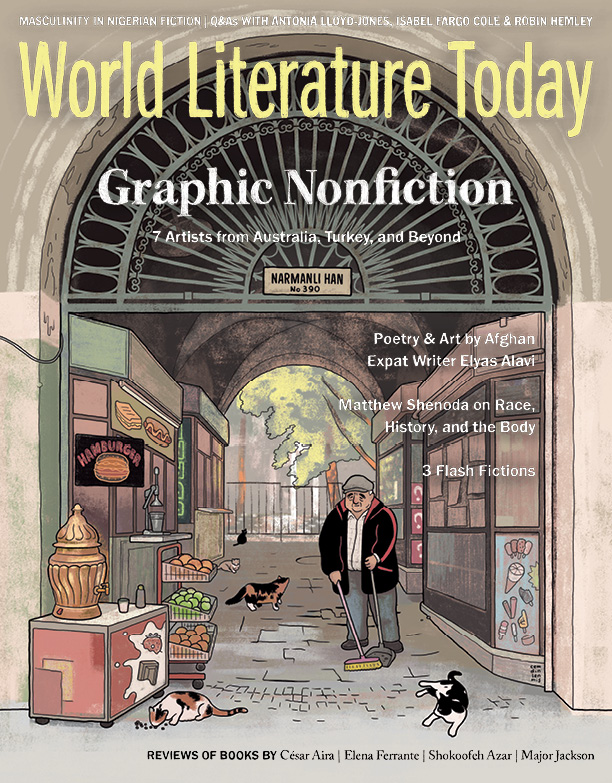Of Comics and Bipolar Disorder: A Conversation with Rachel Lindsay

Rachel Lindsay is a cartoonist based in Vermont and the author of a graphic memoir, RX, that was published in 2018 by Grand Central Publishing. RX explores the powerful interplay of word and image that resists biomedical prescriptivism and espouses the political potential of sharing subjective experiences of living with bipolar disorder through comics. Her comic strip “Rachel Lives Here Now” appears weekly in Seven Days, an alternative newspaper in Vermont.
Sathyaraj Venkatesan & Sweetha Saji: What prompted you to create an autobiographical account of living with bipolar disorder in the comics medium? Were you into comics right from your childhood?
Rachel Lindsay: I drew comics from a young age, mostly comic strips, which I have done throughout my life. When this story presented itself to me, I knew it would be a comic because that stands as my longest and most satisfying way of communicating.
I knew it would be a comic because that stands as my longest and most satisfying way of communicating.
Venkatesan & Saji: How significant are visual metaphors for you in re-creating experiences that transcend literal expressions?
Lindsay: I leaned on visual metaphors a lot in the book in order to help communicate what was going on beneath the surface during my experience. In comics writing, you are always working with the principle of “show versus tell,” negotiating what will be visualized versus written. I felt that it was important to have a very straightforward, unaffected narrator to shepherd the reader through the story, so I used the narration text as a more zoomed-out, hindsight-reflection voice and relied on the visuals to communicate the raw reaction and emotionality in a way that is more easily consumable. The visuals are, literally, the subtext.
The visuals are, literally, the subtext.
Venkatesan and Saji: What choices did you make in presenting yourself in the memoir both visually and verbally? Do you feel that the comic avatar you created is more authentic than a realistic depiction of yourself?
 Lindsay: I’ve been doing autobiographical and semi-autobiographical comics for about twenty years, and over time I’ve developed this way of drawing myself that is sort of an abbreviation of all my features with this inner-child quality in a physical sense. The cartoony-ness of my drawings enables me to have an elasticity to my character—my body and face, especially my eyes—that is the only way I can express the powerful emotions I felt. In many ways, that drawing does feel more like me than my physical body, because that character has represented me for so long in this static form, while my body has changed. However, after completing the book, I am feeling a desire to evolve that character as a reflection of this new stage of my life. I designed the narration, which is my hindsight voice, to be very removed and “sober” to offer a complementary way of expressing my thoughts and feelings that would be palatable to people who could not identify with the emotional aspects of being mentally ill and dealing with involuntary hospitalization, and to encourage them to see the bigger picture.
Lindsay: I’ve been doing autobiographical and semi-autobiographical comics for about twenty years, and over time I’ve developed this way of drawing myself that is sort of an abbreviation of all my features with this inner-child quality in a physical sense. The cartoony-ness of my drawings enables me to have an elasticity to my character—my body and face, especially my eyes—that is the only way I can express the powerful emotions I felt. In many ways, that drawing does feel more like me than my physical body, because that character has represented me for so long in this static form, while my body has changed. However, after completing the book, I am feeling a desire to evolve that character as a reflection of this new stage of my life. I designed the narration, which is my hindsight voice, to be very removed and “sober” to offer a complementary way of expressing my thoughts and feelings that would be palatable to people who could not identify with the emotional aspects of being mentally ill and dealing with involuntary hospitalization, and to encourage them to see the bigger picture.
Venkatesan & Saji: How long did you take to complete the memoir? Would you share the significant aspects of the whole process?
Lindsay: I worked on the book bit by bit from the point of my hospitalization in 2011, but I didn’t start working on it full-time until I got my book deal in March 2016. I finished the book in December 2017. The process of writing the book was extremely traumatic. I was dealing with my usual cycles of highs and lows while simultaneously rehashing the worst time in my life. In addition to that—despite the fact that I had told this story verbally and written about it many times—making a full comic of this experience was like telling it for the first time, in the most honest way possible, in my own language of comics. Drawing my character of myself into these scenarios was almost like experiencing it for the first time, via this version of myself that feels strongly representative of my essential self.
Making a full comic of this experience was like telling it for the first time, in the most honest way possible, in my own language of comics.
Three points during the development of the book really stick out. The first was drawing my father tackling me to the ground prior to being brought to the hospital. Drawing that moment was so upsetting that I had to get up and pace around my house every few minutes.

The second was the opening to the hospital section, “11N,” in which I depict myself on a clipboard and then escaping, only to be caught by the “hand of God”: the doctor/medical personnel of the ward. I had been asking myself: how do I get the reader to still have full compassion for me, even as I am officially stamped crazy by being committed by the doctor, the unquestionable authority of wellness? I also wanted to integrate my hospital notes in some way but again found myself challenged by their clinical, one-sided perception of how I was presenting, which was totally devoid of the context of what I had just experienced—and what the reader had experienced with me. By showing the tension between my character’s actions and this new reality of the clipboard, the reader is confronted with the conflicting perceptions of my identity that were active in my life and given the opportunity to reconcile them on their own, after having developed a relationship with that character over the first half of the book.
The third moment that was a defining point in the creation of the book was the written portion of the chapter “The Fool.” I struggle to fully convey what I thought and felt at the point of being committed and waking up that next morning in the hospital. It involved a lot of anger and disbelief toward the system and the people involved in the incident. I had received feedback from my comics peers and my editor that the anger was overwhelming. I found myself tasked with drilling down into what was going on in my head and heart on a deeper level, and figuring out how to communicate it with language, and I previously had been unable to—and certainly not in the style and tone of the narration up to that point. It took six weeks or more to write those ten sentences, but it was so valuable to me personally as well as many people who have experienced this situation, based on feedback I’ve received. It is the thesis statement of the book. There are so many iterations of it among my papers that I saved from the writing process.
Venkatesan & Saji: Did you feel vulnerable in representing the personal/painful dimensions of your life in the memoir?
Lindsay: At the time of creating RX, I did not feel any sense of vulnerability. I was so hell-bent on making this book that I thought about nothing but getting it done. Now that the book has been out, the tour is over, and I’m back home in my present life, I suddenly do feel incredibly vulnerable. Generally, I feel uncomfortable with people’s insight into my behavior when I am having an episode. I’ve provided a “road map” of my symptoms to the entire world. I recently left two jobs I’ve had for a long time, and though I had been thinking about it for quite a while, I have had concerns that people are reading into it. I have had a huge increase in my post-traumatic stress around the idea of people I care about talking to one another about how I’m becoming manic and that they need to intervene.
I have also felt much more defined by my illness because of all the time I’ve spent promoting the book. I’ve had thirteen speaking engagements since the book came out as well as countless interviews, and they are all about a very specific and traumatic moment in my presentation of this illness that is now almost ten years in the past. I am so happy for the book’s reception and the opportunity to share my story, but it has taken a toll on me and the progress that I have made separating myself from my fear of myself becoming ill and being seen as just a crazy person. Even people who knew I was bipolar may not have understood the gravity of that time, and I think it is scary to some people—am I a wolf to them? I am working on all these feelings, and I do believe they will pass with time. It’s frustrating to have this as the last stage of something that initially felt very empowering.

Venkatesan & Saji: How important, do you think, are memoirs in reclaiming the identity of the mentally ill as against the stereotypes prevalent in popular media? Are you planning any new projects in that direction?
Lindsay: For the purposes of reclaiming identity, I think memoirs about mental illness are most important to people who are mentally ill and people who have family members who are mentally ill. In my experience, Kay Redfield Jamison’s memoir about her bipolar experience, An Unquiet Mind, gave me so much perspective and restored my faith in myself as a competent individual. From there, people like me who have mental illnesses do the heavy lifting for changing stereotypes through their ability to be examples of the strong, resilient, incredible people that we are. Memoirs are important, but that real-life “evidence” has the most power and yields the greatest results in changing perception. I am not planning to do more work about mental illness at this time, but perhaps in the future. I believe it is important to encourage other voices to step forward and share. My voice may appeal to someone who has shared a similar experience but totally turn off someone else that has. That person who is turned off also has an important perspective that needs to be heard.
Memoirs are important, but that real-life “evidence” has the most power and yields the greatest results in changing perception.
Venkatesan & Saji: The graphic medicine community espouses memoirs like yours and inspires many to retell personal narratives of illness and pain. Would you comment on the community’s influence on your work?
Lindsay: The graphic medicine community has been instrumental to my success and the broader awareness of this book. I can never thank them enough for their support and interest in this work. When you complete a project that is this personal, it’s so important to have validation that it was worth opening up such a painful part of your life. They did that for me even before the book was released, when I spoke at the International Graphic Medicine Conference. I respect all of them and the work they’ve done—and continued to do—immensely.
Venkatesan and Saji: Do you think that graphic memoirs can grant space for marginalized voices in the mainstream discourse on bipolar disorder or mental illness in general? In what creative ways could their issues be highlighted against the available models of prescriptive medicine?
Lindsay: I think that the medical community can benefit immensely from reading graphic memoirs about mental illness, and patient experience in general. As I have learned from doctors and health-care practitioners I’ve met on my tour, doctors have such little time and are incredibly stressed out. For this reason, I believe the quicker reading time and visual space of comics—as opposed to the dense medical texts they interact with mostly—is much more feasible for their small windows of time. Also, the visualization of emotional states enabled by the flexibility of the medium is totally unique and really elevates the ability for things that cannot be named in words to be shared.
Venkatesan & Saji: Your reading sessions of RX are often accompanied with music. Would you comment on such a preference?
Lindsay: Actually, I have only had one opportunity to play music with my speaking. It was really, really incredible. I wish I could do it more. Music was more my creative outlet at the time of my hospitalization. In the book, I talk about music and how it helped me connect with other patients, but it also was instrumental to me processing that experience. Comics are a more cerebral means of reflection—they require an immense amount of planning, discipline, and focus. Music gives space to let your mind wander while outputting creative energy. I have written three songs related to the book: one when I was in the hospital; a second when I got my book deal; and the third when I finished my book. They all represent really distinct moments in my emotional relationship to this time in my life and the fulfillment of this promise to myself. They are necessary points of closure to significant events in my life. I do not think I will write another song about this experience.
Venkatesan & Saji: Your Facebook profile features a drawing by a fan. You also maintain an online blog, Rachel Lives Here, with many followers. In what different ways does social media help further your reach? Do the readers’ opinions on your posts influence the style/theme of your narratives?
Lindsay: Yes, that drawing is so adorable. It was made by a girl that attended one of my talks and was about seven years old. I am so grateful to the people that have supported me on social media, which is how I’ve gotten to where I am. I have taken major steps back from it in the past few months. As I said, I’ve been feeling quite vulnerable, and I’ve been feeling increasingly like I need to live in my physical body rather than via a character of myself, and I want people to interact with me that way. I need to remember who I am in the present, not just in the context of that period of my life.
In the past, my readership has really influenced my work, and I tailored my storylines for my strip to what I saw their desires to be—certain humor, certain scenarios, certain characters—and they all took place in Vermont, which is where I live. That was the way that I built confidence in my work and was able to see myself as a cartoonist again, after so much time of not drawing. Now, I am shifting focus to making work that I am really proud of and is interesting to me, and moving away from external validation. At least, that is the goal.
Venkatesan & Saji: In an interview with Edith Zimmerman, you stated that you wrote the memoir RX to reclaim the history of your life. Why do you think that comics has the potential to forge a strong narrative against those perpetuated by medical charts and doctors?
Lindsay: In my travels promoting the book, I had one doctor say to me: “Wow, I’d never thought of my patients as people when I wrote their notes.” That is disgusting. For this reason alone, it is essential for stories like mine, which give enough context to the life of a patient to remind doctors that there is a person with a soul and real relationships and circumstances to contend with, not just a diagnosis and symptoms. As far as those stories being shared as comics, I find comics to be a less intimidating entry point because of the drawings.
Venkatesan & Saji: You have acknowledged Alison Bechdel for her support during the course of drafting the memoir. In what ways did she and her art style inspire you?
Lindsay: I really admire Alison’s courage, and not just with Fun Home, throughout her entire career. She has a very strong voice and a lot of conviction, and expressed that as a cartoonist representing a marginalized population. She has set a powerful example for me.
Venkatesan & Saji: In the chapter entitled “Passing,” you illustrate yourself as a wolf in sheep’s clothing. Elsewhere, you transform into a lone wolf at the workplace. Would you comment on the choice of this specific avatar?
Lindsay: I felt very strange holding the knowledge that I had a mental illness in my life in general but in particular at my workplace, in the role that I had. My illness had also completely upended my life and made me into a person that I didn’t like, and other people didn’t like either. So, the wolf is both a representation of my feelings of fear of myself and my own volatility, and also a play on the “wolf-in-sheep’s-clothing” metaphor, where I am a mentally ill person “passing” as a sane person (sheep in this case also represent complacent followers herded by the system).
Venkatesan and Saji: The last page of RX features a photograph of the memoir’s jacket cover in 2011, which is very different from the one published in 2018. How did the memoir evolve through the seven years since then? Why the title, RX?
Lindsay: Oh wow, so much. I think the stylistic difference with the drawing was a result of the fact that I had not been drawing a lot at that time, and I have now solidified into a consistent style. The rest of the evolution came as a result of the emotional maturity and perspective I developed over those five years (the book was created between 2016 and 2018). The early drafts—mostly written—were very angry. Over time, I gained enough distance from those events to be able to understand other perspectives from that moment, which made for a richer narrative. The title RX is a play on the symbol for prescriptions, and the way I intended it to be written would have had the “R” as the “R” in my signature—an “R” in a circle. In that design, it really indicated how medication was tied to my identity. The idea was vetoed by my publisher, but that was the original intention and origin of the name.
July 2019












